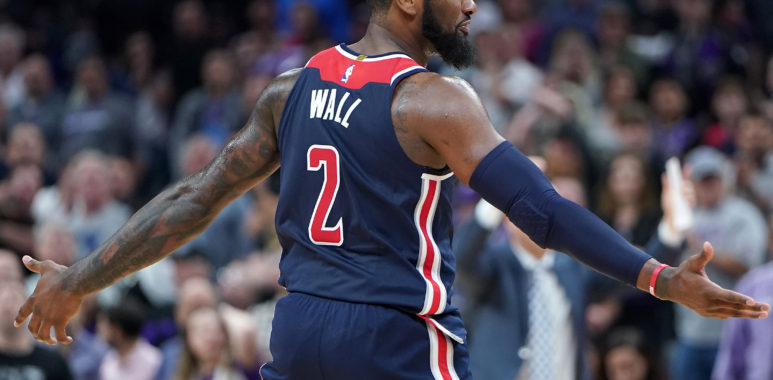
The Washington Wizards Don’t Care Enough to Rebound
Basketball is a two-way game, but the 1-5 Washington Wizards are losing on the defensive end.
They’re hemorrhaging 114.5 points per 100 possessions, a gargantuan number that would’ve ranked bottom of the league last season. Anyone watching their games can see the issue: The Wizards can’t – or at least don’t – rebound.
Their defensive shot profile is roughly average. They aren’t gifting opponents efficient shots at the rim or from deep, and it’s not like opponents are hitting jumpers at an unsustainable rate.
Scott Brooks mainly employs drop coverage in the pick-and-roll, which keeps Washington’s big men in the paint. They’ll switch when the guards get lazy getting over a screen, but either way, the Wizards’ conservative defense keeps them out of rotation and attached to shooters on the back side. Just 7.4 percent of opponent treys come from the corners, stingiest in the league per Basketball-Reference.
This pick-and-roll defense falls apart too often, as I pointed out last week. And Washington’s defensive energy has dipped on the recent West Coast road trip. But overall, the roster is built to play mediocre defense.
And it does. Until the shot goes up.
The Wizards are the worst defensive rebounding team in the NBA, having collected just 64.6 percent of available boards. Opponents are getting two, sometimes three bites at the apple, and Washington has allowed a league-high 19.8 second-chance points per game as a result.
The damage could be even worse. No team allows more putback attempts per game than the Wiz, but vultures on other teams have shot a middling 51 percent on those attempts. If that number ticks up before Brooks finds a solution to his team’s meek rebounding work, Washington will be in real trouble.
An inability to snare boards doesn’t just mean putbacks and easy kickout threes, though. Washington wants to run this year. Their 107.4 pace rating ranks third in the league, and it makes sense. John Wall’s speed turns semi-transition chances into full-blown runouts. Give him a tarmac and he’ll jet past his own man, ram into the chest of the retreating big, and lay the ball home.
But you can’t run if you don’t turn missed shots into rebounds. The Wizards want grab-and-go opportunities, but they’ve apparently forgotten that the phrase begins with “grab.”
Some blame belongs to the bigs. Ian Mahinmi has started at center in Dwight Howard’s stead, and he’s collected just 11 defensive boards in 81 minutes. None of those 11 rebounds were considered “contested” by Synergy. The Frenchman does not win rebounding battles on his own.
Good thing the Wizards start the 6’10” Markieff Morris alongside Mahinmi, right? Well, no. According to our BBall Index talent grades, Morris finished in 54th percentile for defensive rebounding last year compared to bigs with 1000-plus minutes played. Basically average. But he’s declined this year, even handing a win to the Miami Heat after he neglected to box out Kelly Olynyk despite being in perfect position:
powered by Advanced iFrame free. Get the Pro version on CodeCanyon.
Washington’s guards have been the worst culprits on the glass, though. They practice with these bigs each day. They should know how necessary it is to collapse into the paint and gang rebound. But they don’t seem to care:
powered by Advanced iFrame free. Get the Pro version on CodeCanyon.
As Serge Ibaka’s shot clangs off the rim in the play above, Austin Rivers inexplicably vacates the exact area where the ball descends. Tomas Satoransky, meanwhile, seems to think ushering his man into the restricted area is a sound strategy.
Here, Rivers sees Andre Igoudala getting juicy inside position along the baseline – I repeat, he sees his man about to get a rebound – and he continues his casual jog into the paint:
powered by Advanced iFrame free. Get the Pro version on CodeCanyon.
His counterpart Jeff Green does his best wet noodle impression down low. Green is technically a big man, I guess, but his work on the glass has been more Muggsy Bogues than Karl Malone.
This play is the worst:
powered by Advanced iFrame free. Get the Pro version on CodeCanyon.
Jason Smith gets manhandled here, but that’s presumably his job. One of the guards (*cough* John Wall *cough*) is supposed to swoop in and corral the ball at its peak as Smith wrestles with Damion Jones. None of them give enough of a damn to even try.
Wall has just 13 defensive boards in 203 minutes this year. None of them have been contested. Unless the ball literally bounces into his hands, he has no interest moving back toward his own basket, let alone actually fighting for a rebound:
powered by Advanced iFrame free. Get the Pro version on CodeCanyon.
Rebounding is about technique and talent, yes, but it’s also about effort. All of these plays reflect poorly on the players – the ambivalent Wall, the upright Morris, the distracted Mahinmi. They also reflect poorly on Scott Brooks, who must know he doesn’t have the rebounding talent to blame his team’s numbers on the small sample size.
This issue is a major test for Washington’s coach, now in his third season in the capital. He doesn’t need to turn Mahinmi into a vacuum cleaner in the paint or invent some new rebounding scheme. He doesn’t even need to turn them into a good rebounding team; anything better than “historically bad” is fine.
He just needs to extract effort from a notoriously moody locker room. Easier said than done? Sure. But if a player’s first responsibility is to try, then a coach’s first responsibility is to motivate.
The Wizards sometimes look motivated when the ball is on the ground. They look completely apathetic once it’s in the air.
Photo by Thearon W. Henderson/Getty Images
